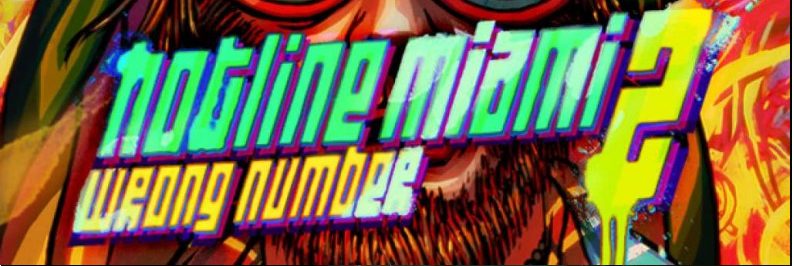Hotline Miami 2: Wrong Number Review
Hotline Miami 2 was a title I always had a certain degree of excitement for. Sequels to such spot-on games as Hotline Miami normally bring with them a large amount of cynicism and criticism from me, as so few of them nail the magic or innovation of the originals. One need look no further than series that went too far, like Spyro the Dragon, Prince of Persia and even, to some extent, Assassin’s Creed to see the issues pulling from the same creative pool for multiple games can create. I was interested to see how Hotline Miami 2, which promised to be the same, beloved style with enough new features to make for an unmistakably different game, could stack up to where sequels surpassed their original inspirations (see Far Cry 3 and 4).
[divider]
There has also been a considerable amount of controversy surrounding Hotline Miami and its sequel with regards to its depiction of violence and the perpetration of it. As an advocate of freedom of expression I naturally fall on the side of “let them do what they want” with regards to video game violence and what could come under “obscenity”. However I feel even those who like their violence moderate still can’t truly criticise Hotline Miami 2 in the way it depicts violence. Yes, the violence is graphic, and yes it is a frequent and unavoidable part of the plot that steadily increases until a gory, shocking climax, much like its prequel. However when looking at films where violence is used as a stylistic device that builds tension, creating a sense of foreboding and dread with regards to the climax of the narrative, as well as a world out of control (such as the franchise’s inspiration, Drive by Nicholas Winding Refn), the violence seems more understandable in its usage.
As well as using the violence stylistically, Hotline Miami 2 also features (without dropping spoilers) several motifs in its narrative that satirise and subtly criticise its own use of violence, leaning less towards gratuity and more towards a self-awareness that gives the violence a politically and socially aware edge, perhaps undermining criticisms that the game is not morally conscious. The violence is also shown having a distinct effect upon the game’s world, and not being consequence-less. Whilst not wanting to spoil the game, I certainly wouldn’t say that any of the characters are “better off” for the violence they perpetrate.
When I initially began playing Hotline Miami 2, the first thing that struck me was the deepening of the visual style and 80s influence that made the previous game so visually striking. The use of VHS-esque effects and motifs in the menus, loading screens and general story layout of the game serve to increase the feeling of immersion, and really bring out the best in the 80s neon, styling the development team Dennaton Games do so well, and that has seen a resurgence recently in games like Far Cry 3: Blood Dragon and the neon powered Fetch in Infamous Second Son. Every visual aspect gamers enjoyed in the previous game is back and beefed up in the best way.
In keeping with this stylistic continuation, the game also has M.O.O.N reprise his role as a score composer for the game, a choice which was right on the money in the first release, and becomes even more experimental and interesting in the second release. What do we buy indie games for if not good musical and avant-garde aesthetic choices, right? He is also joined in scoring by a myriad of other artists, much like in the prequel, who give the game an altogether pleasant collaborative feel. The music is all dark 80s synth, so if you’re into that, be sure to check out the soundtrack, as the whole thing is available online.
Moving on to gameplay, I knew what to expect from the previous game; aggressive, visceral, close combat violence with a breakneck pace and the occasional fire-fight to keep things interesting. I also came expecting a punishing difficulty, which was delivered in spades. Despite my experience of the previous game, I still felt I had been dropped in at the deep end to some extent with the Everest-like difficulty curve and painfully frequent restarts. Whilst this was just about bearable for me and definitely positive for returning players, I felt this move risked putting off new players who had not bought the original, and simply waited for the new edition in the series to be released. Despite the difficulty present in the original, Hotline Miami 2 is on another level in terms of the need to plan, move quickly, and react incredibly fast to avoid yet another brutal restart. Despite the fact that players need to get used to repeated deaths in this game (more so than even Dark Souls) the trial and error gameplay is what we all came here for, and it’s as enjoyable as expected.
The dev team also clearly thought about how to bring the best out of the top-down genre in their level design and implementation of many new weapons, styles and masks, with even a two person mask being an option (yeah I didn’t think it would work either, but it does!). New content is surprising and refreshing, fulfilling the team’s promise entirely. The multiple new playable character additions to the game serve to (whilst initially separating the player from the narrative) flesh out the story and give many different perspectives, playstyles and motivations to the characters, which is a huge plus considering the two playable characters in the prequel.
[divider]
“The fact that both masked and unmasked playable characters exist allows for more depth to dialogue and character”
[divider]
Whilst the fractured, anachronistic storytelling does serve to make the narrative feel less cohesive, it does keep with the mysterious, enigmatic nature of the prequel and keeps the player in the dark even until after the end of the game, despite some key queries being answered. This may not satisfy fans of simple narratives but it does add a little bit extra for the fan of the indie game. The fact that both masked and unmasked playable characters exist also allows for more depth to the dialogue, character and emotionally motivated events. One of these characters is a Vietnam War vet, and that’s exactly the sort of shell-shocked apathy the game world presents alongside the violence within its narrative.
The risen level of difficulty in the game is implemented in such a way as to encourage as much creativity as possible in player responses, and the wildly varying level design allows usage of firearms much more than necessary in the previous instalment, which gives room for more varied playstyles as a result. The difficulty also increases that feeling of reward all players of hardcore games need to feel like they have truly beaten a game. Long live hardcore difficulty, and may handholding stay dead in the indie game.
[divider_top]
 @boargames
@boargames


Comments